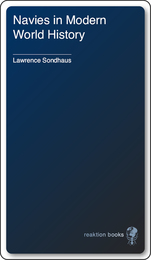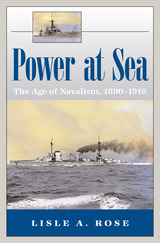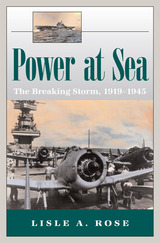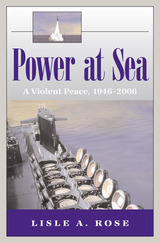4 books about Navies

Navies in Modern World History
Lawrence Sondhaus
Reaktion Books, 2004
Navies in Modern World History traces the role of navies in history from the early nineteenth century, through both World Wars, to the dawn of the twenty-first century and beyond.
In a series of case studies Lawrence Sondhaus examines the national fleets of Britain, France, Germany, the United States, Japan, Brazil, Chile and the Soviet Union, and demonstrates the variety of ways in which each country has made decisive use of naval power. In each case the author argues that the navy in question helped change the course of modern world history; he also systematically analyses the challenges navies faced in assembling matériel, training personnel and performing their mission.
This book discusses the leading role of navies and shipbuilders in key technological innovations of the nineteenth and early twentieth centuries, including advances in steam power, armor, artillery and torpedoes, and looks at aircraft carrier design and naval aviation in general in the second half of the twentieth century. It also explains how, today, technological breakthroughs are centered around naval stealth and maritime propulsion systems. Special attention is devoted to the evolving state of naval technology, and the book shows how the relative industrial capabilities of seafaring countries have been reflected in their maritime building programs, providing an important link between the evolution of modern national fleets and the broader history of the period.
In a series of case studies Lawrence Sondhaus examines the national fleets of Britain, France, Germany, the United States, Japan, Brazil, Chile and the Soviet Union, and demonstrates the variety of ways in which each country has made decisive use of naval power. In each case the author argues that the navy in question helped change the course of modern world history; he also systematically analyses the challenges navies faced in assembling matériel, training personnel and performing their mission.
This book discusses the leading role of navies and shipbuilders in key technological innovations of the nineteenth and early twentieth centuries, including advances in steam power, armor, artillery and torpedoes, and looks at aircraft carrier design and naval aviation in general in the second half of the twentieth century. It also explains how, today, technological breakthroughs are centered around naval stealth and maritime propulsion systems. Special attention is devoted to the evolving state of naval technology, and the book shows how the relative industrial capabilities of seafaring countries have been reflected in their maritime building programs, providing an important link between the evolution of modern national fleets and the broader history of the period.
[more]

Power at Sea, Volume 1
The Age of Navalism, 1890-1918
Lisle A. Rose
University of Missouri Press, 2006
The twentieth century was preeminently an age of warring states and collapsing empires. Industrialism brought not peace but the sword. And the tip of that sword was sea power.
In Power at Sea, Lisle A. Rose gives us an unprecedented narrative assessment of modern sea power, how it emerged from the Age of Fighting Sail, how it was employed in war and peace, and how it has shaped the life of the human community over the past century and a quarter. In this first volume, Rose recalls the early twentieth-century world of emerging, predatory industrial nations engaging in the last major scramble for global markets and empire. In such times, an imposing war fleet was essential to both national security and international prestige. Battleship navies became pawns of power politics, and between 1890 and 1914 four of them--Britain’s Royal Navy, the Imperial German Navy, the Japanese Navy, and the U.S. Navy--set the tone and rhythm of international life.
Employing a global canvas, Rose portrays the increasingly frantic naval race between Britain and Germany that did so much to bring about the First World War; he takes us aboard America’s Great White Fleet as it circumnavigated the world between 1907 and 1909, leaving in its wake both goodwill and jealousy; he details Japan’s growing naval and military power and the hunger for unlimited expansion that resulted.
Important naval battles were fought in those days of ostensible peace, and Rose brings to life the encounters of still young and relatively small industrial fighting fleets at Manila Bay and Tsushima. He also takes us into the huge naval factories where the engines of war were forged. He invites us aboard the imperial battleships and battle cruisers, exploring the dramatically divided worlds of the officers’ lordly wardroom with its clublike atmosphere and the often foul and fetid enlisted men’s quarters.
The Age of Navalism climaxed in the epic First World War Battle of Jutland, in which massive guns and maneuvering dreadnoughts determined that Imperial Germany would become the latest in a line of ambitious naval powers that failed to shake Britannia’s rule of the waves. Germany’s subsequent use of a revolutionary new strategy, unrestricted submarine warfare, nearly brought Britain to its knees, reduced the level of naval combat to barbarism, and brought the United States into the war with its own substantial navy, ultimately turning the tide of battle.
Focusing as much on social issues and technological advances as on combat, Power at Sea: The Age of Navalism tells a compelling story of newfound power that is fascinating in its own right. Yet, it is merely a prologue to more startling accounts contained in the author’s succeeding volumes.
[more]

Power at Sea, Volume 2
The Breaking Storm, 1919-1945
Lisle A. Rose
University of Missouri Press, 2006
After 1921, the clouds of suspicion and resentment left by the Great War gradually obscured the strenuous efforts of negotiating statesmen and led to ever greater appetites for power at sea. By the midthirties, worried admiralties around the world were bracing themselves for a new and deadlier round of global violence. In this monumental study, Lisle A. Rose revisits the strategies, battles, ships, planes, weapons, and people of the most destructive war in history to show the decisive influence of sea power upon its outcome.
During the years preceding World War II, Britain’s once dominant Royal Navy, beset by national economic decline and steadily eroding morale within the fleet, pleaded for the appeasement of dictators in Europe and the Far East in an attempt to avoid a three-front maritime war that would surely doom the British Empire. Desperately hoping for time to build a formidable fleet, Hitler’s admirals feverishly tried to rebuild German naval weaponry upon a technological foundation not much improved since 1918. In the end, it was Japan and the United States, facing each other across the broad Pacific, that moved naval history into a new phase by fashioning ultramodern navies based on the integration of sea, air, and amphibious forces.
Rose relates how the strengths and weaknesses of seafaring nations came into play within the crucible of a six-year war during which naval encounters were every bit as critical and frequent as land-based fighting. He recounts the well-known naval battles and operations of World War II from a novel perspective, placing them in the context of daring gambles open to both the Axis and the Allies that were either seized upon or ignored. Once Britain’s survival was assured, and the Allies held on in the North Atlantic and the Pacific, however, the superior industrial culture of the United States doomed the Axis. After 1943, America threw into the deadly battles against the German U-boats and the Japanese fleet more and better ships, more and better citizen sailors, better intelligence, and better strategies than did its antagonists or allies.
Two years later, the United States had not only defeated the Axis, it had also won control of the world’s oceans from its exhausted British ally. In the process, it had begun a revolutionary transition in which power at sea became power from the sea. Whether recounting the heart-stopping action of naval encounters or analyzing the technologies that made victory possible, Rose traces in vigorous, memorable prose the dramatic emergence of a new naval power that would leave all others in its wake.
[more]

Power at Sea, Volume 3
A Violent Peace, 1946-2006
Lisle A. Rose
University of Missouri Press, 2006
Bringing to a close his epic recounting of naval power in the twentieth century, Lisle Rose describes the virtual disappearance after 1945 of all but one great navy, whose existence and operations over the next sixty years guaranteed a freedom of the seas so complete as to be at once universally acknowledged and ignored.
In the first twenty years after World War II, the U.S. Navy continued the revolutionary transformation of sea power begun in the 1930s with the integration of sea, air, and amphibious capabilities. Between 1946 and 1961, the United States placed on, above, and beneath the world’s oceans the mightiest concentration of military power in history. Supercarriers filled with aircraft capable of long-range nuclear strikes were joined by strategic ballistic missile submarines, even one of whose sixteen nuclear-tipped missiles could devastate most of an enemy’s major urban centers together with its industrial and military infrastructure.
Such a fleet was incredibly costly. No ally or adversary in a world recovering slowly from global war could afford to build and maintain such an awesome entity. Its needs constantly had to be balanced against competing requirements of a broader national defense establishment. But the U.S. Navy ensured an unchallenged Pax Americana, and its warships steamed where they wished throughout the globe in support of a policy to contain the influence and threat represented by the Soviet Union and China.
The 1962 Cuban missile crisis, however, galvanized the Soviet leadership to construct a powerful blue-water fleet that within less than a decade began to challenge the United States for global maritime supremacy, even as its own ballistic missile boats posed a massive threat to U.S. national security. While the Soviets enjoyed the luxury of building exclusively against the U.S. Navy and challenging it at almost every point, America’s sailors were increasingly burdened by a broad array of specific missions: fighting two regional wars in Asia, intervening in Lebanon, protecting Taiwan, aiding in the preservation of Israel, and maintaining close surveillance of Cuba, chief among them. Confronting ever-growing Soviet sea power stretched U.S. capabilities to the limit even as the fleet itself underwent revolutionary changes in its social composition.
The abrupt decline and fall of the Soviet Union after 1989 led to another reappraisal of the importance, even necessity, of navies. But the turbulent Middle East and the struggle against international terrorism after 2001 have demanded a projection of sea-air-amphibious power onto coasts and adjacent areas similar to that which America’s fleets had already undertaken in Korea, Vietnam, and Lebanon.
The U.S. Navy now sails on the front line of defense against terrorism—a threat that confronts strategists with the greatest challenge yet to the ongoing relevance of maritime power. This third volume of Rose’s majestic work offers readers an up-close look at the emergence of America’s naval might and establishes Power at Sea as essential in tracing the emergence of U.S. dominance and understanding the continuing importance of ships and sailors in international power plays.
[more]
READERS
Browse our collection.
PUBLISHERS
See BiblioVault's publisher services.
STUDENT SERVICES
Files for college accessibility offices.
UChicago Accessibility Resources
home | accessibility | search | about | contact us
BiblioVault ® 2001 - 2024
The University of Chicago Press









